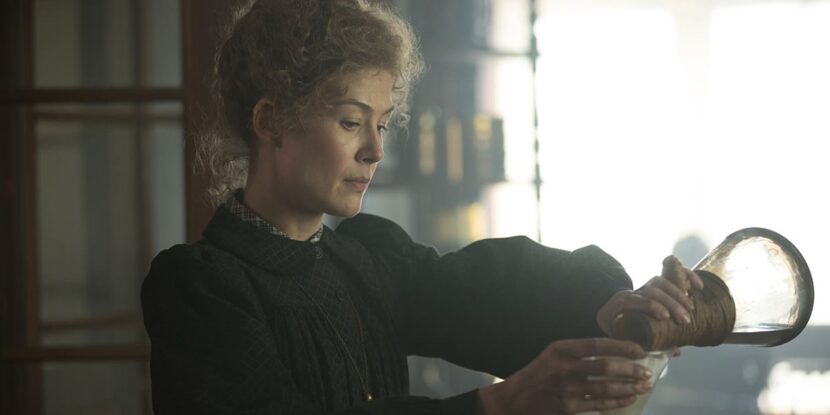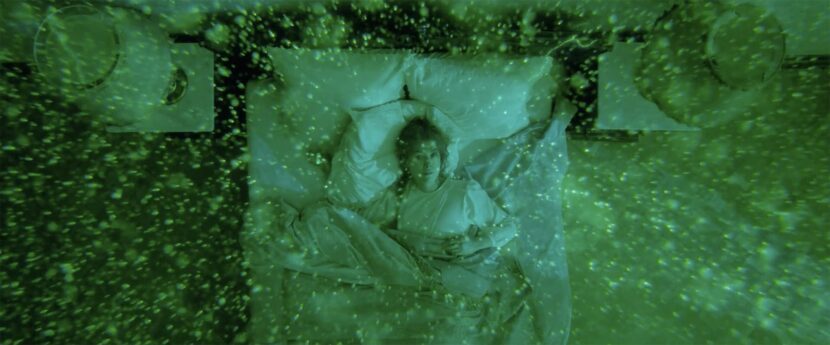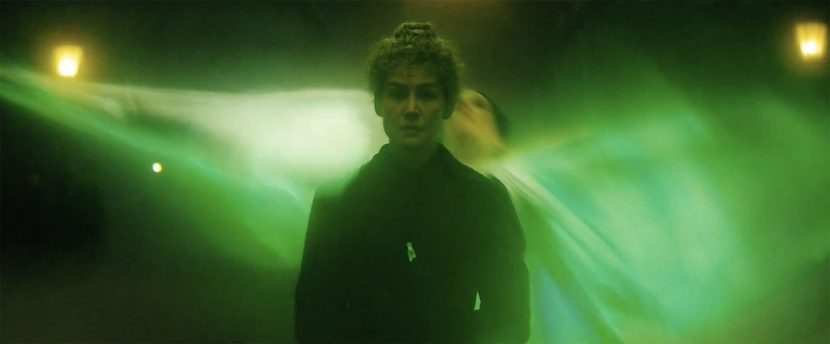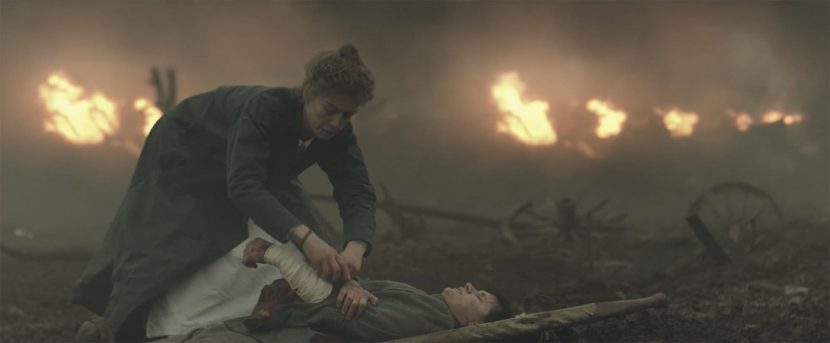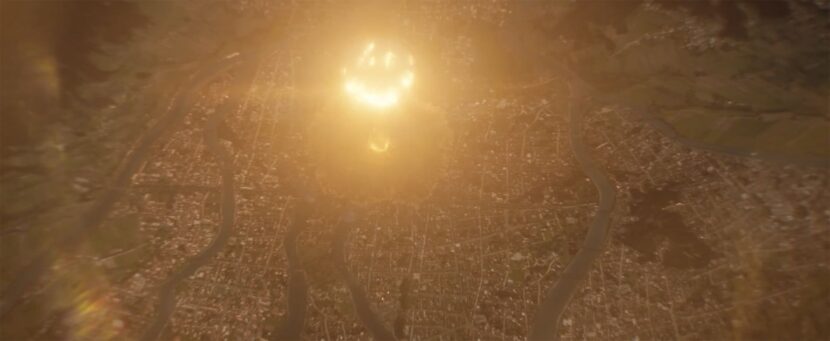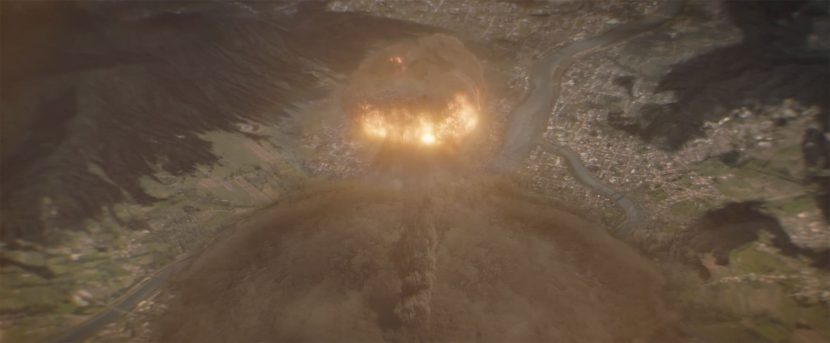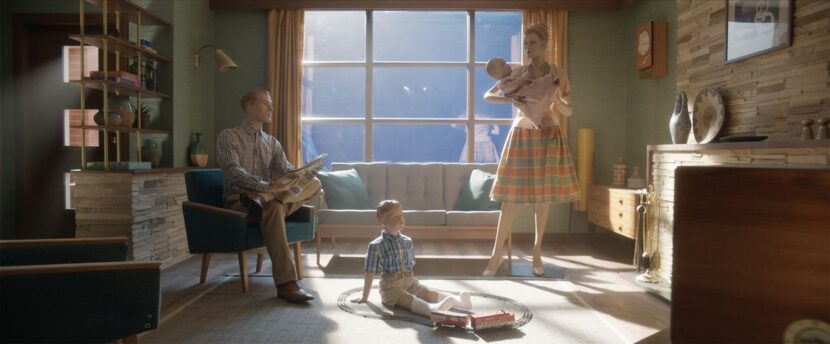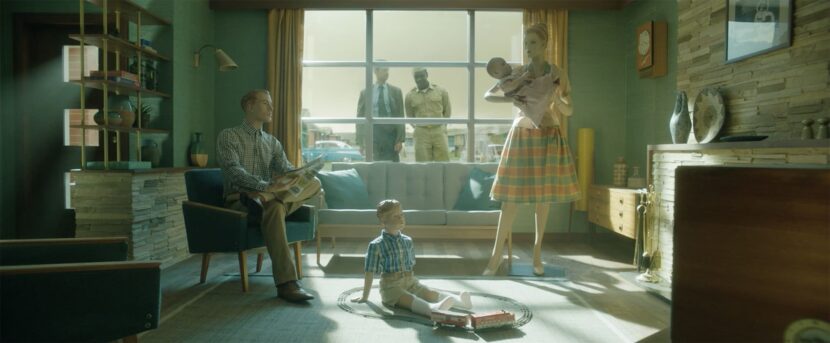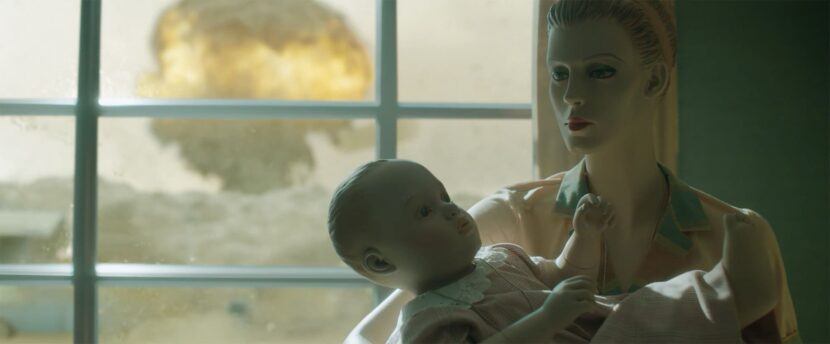Directed by Academy Award nominee Marjane Satrapi, Radioactive tells the story of the pioneering work of Marie Curie based on the graphic novel ‘Radioactive: Marie & Pierre Curie: A Tale of Love and Fallout’ by Lauren Redniss. In the male-dominated society of late 19th century Paris, Marie Curie was a Polish and naturalized-French physicist and chemist who conducted pioneering research on radioactivity. She was the first woman to win a Nobel Prize, the first person and the only woman to win the Nobel Prize twice, and the only person, man or woman, to win these two Nobel Prizes in two unique scientific fields.
Rosamund Pike plays Marie Curie as a fiercely passionate scientist, who struggles to progress her ground-breaking research, despite her obvious brilliance. Joining forces with fellow scientist and her future husband, Pierre Curie, they take her exploration of radioactivity forward, discovering not one, but two new elements: radium and polonium.
The film covers her early years and those after the tragic death of her husband, Pierre. The film is interesting as it also interweaves glimpses into the future. It includes insights into the positive and negative outcomes of Curie’s exploration of radioactive elements.
The visual effects were provided by Union VFX in England. From the outset, this project was a creative collaboration between Union’s VFX Supervisor Simon Hughes and Director Marjane Satrapi. This collaboration was critical in building a creative language that could be used throughout the film. Satrapi has a background in animation and “is creatively experimental and brave, making her very exciting to work with,” commented Union’s MD Lucy Cooper. “She had created extensive animatics and storyboards and provided lots of references which helped guide us to a common creative vision on the more conceptual design elements.”
Union’s work was often used to illustrate science to the audience either by way of explanation or in a more abstract sense to marry Marie Curie’s thoughts and dreams to her research. The Union team conducted extensive research into fusion, cell structures, and how radium behaves in a cloud chamber to inspire creative interpretations based on reality. As shown in the film, Marie Curie was able to isolate pure radium, an element that is a million times more radioactive than uranium. Radium salts also possess a remarkable quality: they glow in the dark, are warm to the touch, and seem to give off an inexhaustible supply of heat. The green glow and eerie glowing properties of radium influenced many aspects of the film’s visual and VFX. While the film is a period drama, it also has both flashes forward into the future and highly stylized interpretations of the atomic research. “We showed the splitting of the atom to discover radium, into which we introduced a photographic quality so that it didn’t feel like an education video,” explains Hughes.
When Marie meets Pierre and they bond together in science and marriage, “a beautiful visualisation shows the shadows of them making love ascend twisting towards a twinkling night sky which morphs into a fantastical idea of ‘creation’ using a scientifically accurate vision of how atoms move around polonium,” Hughes adds. 3D scanning actors Rosamund Pike and Sam Riley wearing nude suits standing entwined provided Union with an asset that they could place in a replica 3D bedroom and cast light over thereby generating the shadows which the team then animated. This builds to a starry polonium sky which was created in Houdini.
After her husband’s death, Currie’s dreams are influenced heavily by the impact of their work. She is shown actually going to bed each night with a vile of glowing Radium. At which point the film places her at the centre of a complex Radium dance that mimics the scientific phenomena enveloping around her, – somewhere between art and science.
The dance choreography was inspired by Loie Fuller, a pioneer of dance whose performances combined modern dance, costume, and theatrical lighting techniques. Fuller had regularly performed at the Folies Bergère music hall in Paris so Curie could well have actually seen her before the first World War.
This beautiful complex sequence has a lot of cuts (60 VFX shots in total) and the bluey-green silk costume had LED strips sewn into it to light it up from within. These combined factors would have made blue or greenscreen very hard to handle, so a grey background was chosen for the studio shoot in Budapest. “When retimed in Kronos, the in-costume light artifacts looked like electrical charges producing a kind of temporal effect that we embraced as part of an overall treatment to create the ethereal effect,” says Hughes. “We then had to place Marie and the dancers into a fully CG Samaritaine environment complete with cobblestone street in order to relight with FX to give it a three-dimensional feel.”
In a related scene, Curie also sees her husband’s coffin with blood leaking out from the sides onto cobblestones. This was achieved using CG blood combined with elements of fluid dissipating – shot on a Phantom camera at a high frame rate. Initially, this sequence was going to be a much larger sequence with the cobblestones falling away, but it was reduced to better work in the edit and the flow of the story.
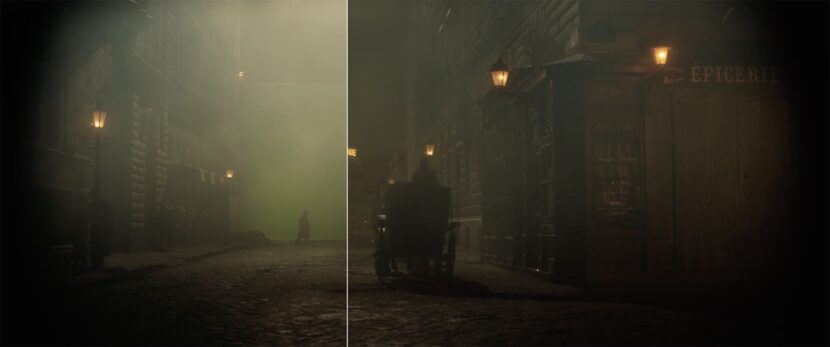
The biggest environmental challenge was creating a fully CG version of Paris complete with La Samaritaine. There were no plates that the team could use, but the Union team did have rooftop photography from a previous shoot and elements from a location survey in Budapest to help. The team added little touches such as matching the blown bulbs on the sign, as well as adding a small animated cat on the roof add reality and detail.

Currie’s husband Pierre meets with a dramatic end, being trampled by a horse-drawn carriage while walking home. To show this, the filmmakers combined VFX, face replacement, and stunts. “We had to create a fully CG Rue du Pont Neuf bridge complete with cars and people on the street and replace the stunt actor using a mix of digital doubles and the footage we shot of Sam on the night,” explained Hughes. “We also removed the support stunt people and added a painting-esque effect to provide the stylised look Marjane was after.”
The shoot took place at 3 am in the morning in -10 degree cold and was filmed at slow speed. “With each pass, we logged the camera position and got Sam to walk in at the end to film plates that we could use to replace the stuntman,” Hughes recalls. “We also lidar scanned him in costume so that we could place him right in the heart of the fatal action using head replacement techniques and animated facial expressions based on the plates”. The end sequence is both shocking and tragic. In many ways, his death is a key turning point in the film.
As German troops advanced toward Paris, Currie knew her scientific research needed to be put on hold. The actual Marie Curie gathered her entire stock of radium, put it in a lead-lined container, transported it by train to 375 miles away to Bordeaux. She locked it in a safety deposit box at a local bank. She then returned to Paris, confident that she would return to her radium research after France had won the war. Rather than flee the turmoil, she decided to join in the fight, this required Union to create the battlefields of WW1.
“Our World War I battlefield environment was based on a shoot in a cold, muddy field outside of Budapest,” says Hughes. “There wasn’t much dressed set so we used our Blackmagic (camera) to create a library of elements”. There was also and only one vehicle which required the modleling of a CG version to allow the creation of a fleet of them heading into battle. During the war, Currie’s daughter persuades her to volunteer for the war effort taking her portable x-ray machines or ‘Petites Curies’, into the field to help avoid unnecessary amputations of wounded soldiers. More than a million actual French soldiers benefited from this during the war.
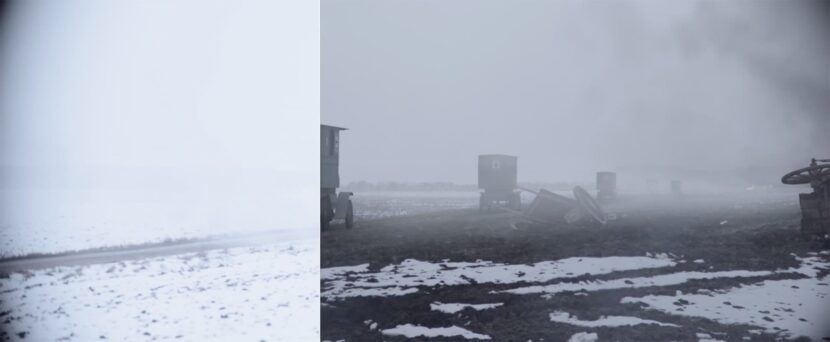
In the shot above the actual plate on the left, had virtually no detail due to the real fog and snow. The Union team had to remove snow not just add it, to make the shots, and this sequence work visually.
“Transforming our snowy, foggy plate required a big matte painting and the addition of splashes as the wheels went through the puddles as well as smoke and fire,” comments Hughes. A lot of the matte painting was done in comp, including some very complex dense smoke shots where Currie’s hair presented real challenges.
Currie also experiences a whole ward filled with versions of her dead husband in one of her visions. To achieve this Union used split-screen techniques replacing extras (chosen with similar body shapes and beards) with multiple digital Sam Rileys built from a 3D scan of Sam aided by key lighting reference.
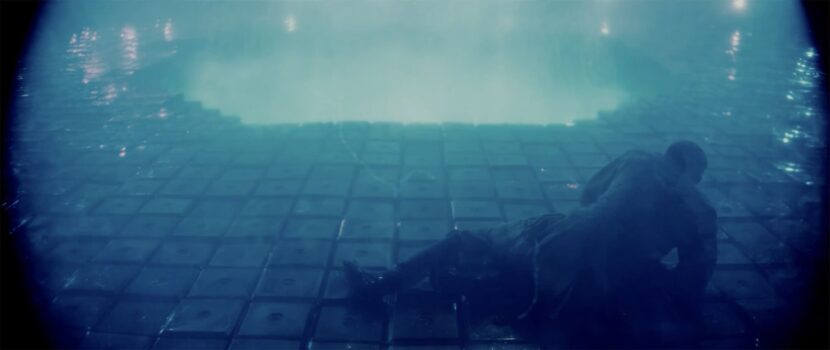
One of the most devastating impacts of nuclear physics and scientific radiation research has been the Chernobyl disaster. The film again links these events with a rich visual montage that brings the viewer into the modern era and inside the burning Russian reactor.
Of course, nobody actually knows what it was really like, but first-hand accounts describe a very different type of fire and the director opted for a very stylised, hyper-real, painterly aesthetic with an interesting colour palette for the shots inside and outside of the plant.
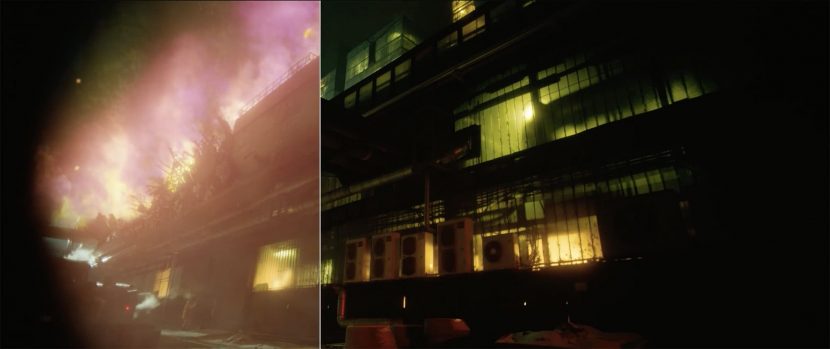
“We did an elements shoot where we filmed all sorts of gasses on fire at the top of a hill against the sky at different frame rates and mixed them with a 2.5D DMP and some CG building structure and rubble components to create the stylised look visualised by Marjane and Cinematographer Anthony Dod Mantle” recalls Hughes.
Inside the central chamber, Union added a waterfall and steam coming off the ground using fx and elements that included pouring salt at slow frame rates. The whole room was engulfed in a kind of cloud of particles and strands which was inspired by their research into radium’s actual behaviour in a cloud chamber. “We also found some old photographic references from within other reactors and mimicked the distortions found on many of those,” Hughes adds.
Nuclear weapons are also a consequence of Curie’s science and the film shows the testing of these in Doomtown, Nevada, a test site established in 1951. Doomtown is a replica US suburban town complete with mannequins dressed by store JC Penny.
“Our Doomtown was shot in Almeria, Spain where we extended the set and added mountain ranges using a mix of CG and 2.5D DMPs. Our anticipated blue skies didn’t materialise and instead, we experienced a huge dust storm complete with oppressive, orange skies. The decision was made to embrace these and replace earlier shots” explains Hughes.
The production filmed in Budapest, the invited 1950s audience, who watched the test explosions wearing ski-goggles as their only protection. Union then placed them into the Almeria environment.
To show the impact on the mock town, the production built two identically proportioned rooms, one complete with mannequins and home furnishings and one painted entirely black and empty. The inhabited room was rigged with wires and SFX did as much damage as the team could.
In the black set, Union worked with the SFX team to match the camera angles and shoot more flammable elements before marrying it all together with the addition of a dust storm created in Houdini that blows through the window.
Union’s biggest challenge on this job was recreating the Hiroshima bomb drop which involved building a fully CG Enola Gay airplane which then drops it’s ‘Little Boy’ payload. The view of Hiroshima is based on drone footage of Thailand manipulated into a matte painted environment complete with Hiroshima’s geographically correct river network. “We had to take our cameras higher than drone flying height, but were able to tile it together,” Hughes points out. “The impact and ensuing mushroom cloud was our biggest FX shot to date at the time. We did an element shoot of Dettol being piped through a hole in a black card in two large fish tanks which we filmed from two different camera positions at normal and high speed to provide some nice elements, but the shot was largely FX driven”.
Union’s work covered a wide array of types of effects, and some much more artistic and interpretative than the company is normally known for, Union VFX has a strong reputation in invisible high-end effects. “This was a unique opportunity to collaborate with a very creative director with a strong vision. Marjane gave us a lot of creative freedom to come up with a visual language based on science to help marry Marie’s story to the impact of her work”. Hughes explains. “It provided the opportunity for us to drive the creative and style. It was great to get stuck into lots of scientific research and flex our design, CG and FX muscles to show what we’re capable of.”

